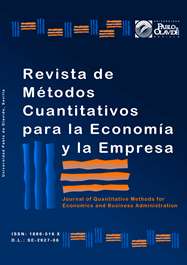Credit Risk Models: Practical Application to a Mortgage Refinancing Model
DOI:
https://doi.org/10.46661/revmetodoscuanteconempresa.2976Keywords:
credit risk, dynamic optimization, dynamic programming, interest rate, mortgage refinancing, mortgaged backed securities, Basel IIIAbstract
Facing an hypothetical, but increasingly, case of default risk on a mortgage or a fall in interest rates, an important issue raised by the borrower is the possibility of minimizing that risk by selecting the best refinancing option. In this paper, a mortgage refinancing model is presented, developing a purely quantitative programming method with a simulation based on an algorithm created especially for this case and that can be useful for mortgage debtors. Thus, we begin by explaining the theoretical basis on which the research is based, to proceed to develop the problem, continuing with its implementation. Finally, the results are analyzed and the most relevant conclusions are commented.
Downloads
References
Campbell, J.Y. (2012). Mortgage Market Design, NBER Working Paper, nº w1939.
Capuano, C. (2008). Recent Advances in Credit Risk Modelling, IMF Working Paper.
Hannoun, H. (2010). The Basel III Capital Framework: A Decisive Breakthrough. BoJ-BIS high Level Seminar on "Financial Regulatory Reform: Implications for Asia and the Pacific", Hong Kong SAR, 22 November 2010.
Kalotay, A.J., Yang, D., & Fabozzi, F.J. (2008). Optimal Mortgage Refinancing: Application of Bond Valuation Tools to Household Risk Management. Applied Financial Econometric Letters, 4, 141-149.
Longstaff, F.A. (2005). Optimal Recursive Refinancing and the Valuation of Mortgage-Backed Securities. Real Estate Economics, 33(4), 619-661.
Pliska, S.R. (2006). Mortgage Valuation and Optimal Refinancing. Stochastic Finance, Springer.
Rasmussen, K.M., Madsen, C.A., & Poulsen, R. (2014). Can Home Owners Benefit from Stochastic Programming Models? - A Study of Mortgage Choice in Denmark. Computational Management Science, 11(1), 5-23.
Roncoroni, A., & Moro, A. (2006). Flexible-Rate Mortgages. International Journal of Business, 11(2), 143-157.
Roncoroni, A., & Fusai, G. (2008). Implementing Models in Quantitative Finance: Methods and Cases, 2nd ed, Springer.
Sy, W. (2008). Credit Risk Models: Why They Failed in Credit Crisis. Australian Prudential Regulation Authority (Sydney).
Tai, L.S., & Przasnyski, Z. H. (2000). Evaluating Refinancing Strategies Precisely. Journal of Financial and Strategic Decisions, 13(3), 9-21.
Walter, S. (2010). Basel III and Financial Stability. 5th Biennial Conference on Risk Management and Supervision. Financial Stability Institute, Bank for International Settlements, Basel, 3-4 November 2010.
Downloads
Published
How to Cite
Issue
Section
License
Copyright (c) 2019 Journal of Quantitative Methods for Economics and Business Administration

This work is licensed under a Creative Commons Attribution-ShareAlike 4.0 International License.
Submission of manuscripts implies that the work described has not been published before (except in the form of an abstract or as part of thesis), that it is not under consideration for publication elsewhere and that, in case of acceptance, the authors agree to automatic transfer of the copyright to the Journal for its publication and dissemination. Authors retain the authors' right to use and share the article according to a personal or instutional use or scholarly sharing purposes; in addition, they retain patent, trademark and other intellectual property rights (including research data).
All the articles are published in the Journal under the Creative Commons license CC-BY-SA (Attribution-ShareAlike). It is allowed a commercial use of the work (always including the author attribution) and other derivative works, which must be released under the same license as the original work.
Up to Volume 21, this Journal has been licensing the articles under the Creative Commons license CC-BY-SA 3.0 ES. Starting from Volume 22, the Creative Commons license CC-BY-SA 4.0 is used.










